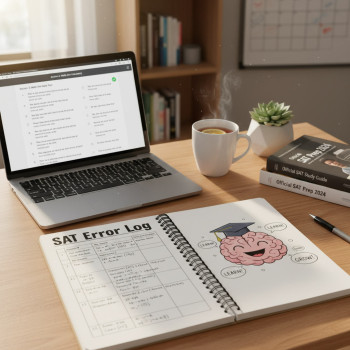Why graphs matter on the Digital SAT (and why you should love them)
Graphs are the visual vocabulary of both the Math and the Reading & Writing sections of the Digital SAT. They show up as a compact way to present data, relationships, and trends — and the test-writers love them because a single visual can test many skills at once: interpretation, calculation, inference, and sometimes a little healthy skepticism.
If you picture a graph as a story about numbers, your job on test day is to read the story carefully and answer what the author (the test-maker) is actually asking — not what you imagine they meant. This guide walks you through the common graph types you’ll meet, how to approach them efficiently, and practical strategies to boost accuracy and speed. We’ll also sprinkle in examples, a comparison table, and study tips, including how Sparkl’s personalized tutoring can sharpen the areas where you most need help.
An overview: Which graphs show up where?
Before diving into each graph, it helps to know where graphs typically appear:
- Math — Problem-Solving and Data Analysis often uses tables, line graphs, bar graphs, scatterplots, and pie charts. These can appear in word problems, real-world contexts, or as part of multi-step scenarios.
- Reading & Writing — Informational graphics (tables, bar graphs, line graphs) appear as companion visuals. Questions ask you to interpret data, connect evidence to claims, or evaluate the author’s use of the graphic.
Now let’s unpack each graph type, with what to watch for and example question stems you should be comfortable answering.
Line graphs
What they show
Line graphs display how a quantity changes over a continuous axis — usually time. They’re great for spotting trends, rates of change, and turning points.
What the SAT tests with line graphs
- Reading values off the graph (interpolation and sometimes extrapolation).
- Comparing slopes or rates between segments.
- Identifying where a variable increases/decreases or stabilizes.
- Interpreting combined line graphs (two or more lines on one plot).
Strategy and example
Always check the axes first: what units are used, are there breaks in the axis, and is the scale linear? If the x-axis is time, read left-to-right for chronological flow. For slope comparisons, remember: steeper means faster change, not necessarily larger total.
Example task: “Point A is at (2009, 40) and Point B is at (2012, 70). What was the average annual increase between 2009 and 2012?” Quick method: change in value divided by change in years → (70 – 40) / (2012 – 2009) = 30/3 = 10 units per year.
Bar graphs
What they show
Bar graphs compare discrete categories — quantities associated with labels. They’re visual, direct, and excellent for quick comparisons.
What the SAT tests with bar graphs
- Comparisons among categories (largest, smallest, difference between categories).
- Reading heights accurately; sometimes grouped bar charts (two bars per category) to show subgroups.
- Using bar charts as evidence in Reading & Writing — linking a claim to a visible pattern.
Strategy and example
Look for total vs. relative comparisons. If the question asks for percentage increases or ratios, compute precisely rather than eyeballing unless the values are obvious. When bars are grouped, be careful to match the correct subgroup to the correct category.
Example task: “If Category X has value 120 and Category Y has value 80, what percent greater is X than Y?” Calculate: (120 – 80)/80 = 40/80 = 0.5 → 50% greater.
Scatterplots (with trend lines)
What they show
Scatterplots plot pairs of numbers to show relationships between two variables. Sometimes the SAT will include a best-fit line or ask you to infer correlation strength and direction.
What the SAT tests with scatterplots
- Interpreting correlation: positive, negative, or little/no correlation.
- Reading coordinates for specific points.
- Using a trend line to estimate values or predict a change.
- Recognizing outliers and how they affect interpretation.
Strategy and example
Don’t get lost in individual points — first ask: do points generally go up, down, or scatter? If a trend line is given, use it for estimation. When the question asks about causation, be cautious: correlation does not mean causation — and the SAT sometimes tests that exact idea in Reading & Writing passages.
Example task: “Which of the following best describes the relationship shown?” Correct answers will use language like “strong positive correlation” or “no linear correlation.” Avoid absolute words like “causes.”
Pie charts
What they show
Pie charts divide a whole into parts — percentages or fractions of a total. They’re often used in Reading & Writing to illustrate composition of a dataset.
What the SAT tests with pie charts
- Comparing slice sizes (percent and fraction reasoning).
- Converting between degrees, fractions, and percentages if needed.
- Understanding whether the chart accounts for the entire whole or a subset.
Strategy and example
If percentages are given, use them directly. If raw counts are provided for a slice and you need the percent, divide by total and multiply by 100. Be wary of small slices — they’re easy to misread visually.
Example task: “Three slices represent 25%, 35%, and 40%. If the total is 200 students, how many correspond to the 35% slice?” Answer: 0.35 × 200 = 70 students.
Tables
What they show
Tables are compact, precise presentations of numerical or categorical data. They’re often used for multi-part questions where you’ll have to extract, compute, and compare values.
What the SAT tests with tables
- Reading the correct row/column.
- Calculating sums, differences, averages, percentages, and ratios from table entries.
- Interpreting labels and footnotes — sometimes a cell is marked “n/a” or the unit is different across rows.
Strategy and example
Scan headers and footnotes before doing any math. If a question asks for the difference between two aggregated categories, compute carefully and consider whether you need to combine multiple rows/columns first.
Example task: “Using the table, what is the average of column A for years 2010–2014?” Add the listed values for those years and divide by 5. Simple arithmetic done methodically beats mental shortcuts that could slip up under pressure.
Mixed visuals and data-integrated questions
Sometimes the SAT combines a short passage with a graph or table. You’ll be asked to use the graphic to evaluate a claim, pick evidence, or decide whether the author’s conclusion is fully supported by the data. In Reading & Writing, these questions test both data literacy and textual analysis.
Typical question types
- Which data point most directly supports the author’s claim?
- Does the graphic contradict, support, or neither for the passage’s claim?
- Which interpretation of the data is the most reasonable?
Strategy
If the passage makes a claim and the graphic is nearby, compare carefully: does the passage speak about averages while the graphic shows medians? Does a small subgroup drive the effect? These nuances matter. If you’re unsure, look for the most direct, text-evidence-based answer rather than the one that feels right.
Common traps and how to avoid them
- Misreading axes: Always check the labels and units. A graph with logarithmic scaling or unequal intervals can trick you.
- Confusing correlation with causation: Many Reading & Writing prompts test your ability to notice when a conclusion overreaches the data.
- Eyeballing instead of calculating: Visual estimates are useful, but when choices are close, compute the exact value.
- Wrong aggregation: If aggregating categories, confirm you’re summing the correct rows/columns and not double-counting or missing footnotes.
- Outliers: A single extreme point can markedly change averages — always consider median or range if mentioned.
Quick reference comparison table
| Graph Type | Best for | Common SAT tasks | Key tip |
|---|---|---|---|
| Line Graph | Trends over time | Rates of change, comparisons of slopes, interpolation | Check axis units & slope meaning |
| Bar Graph | Comparing categories | Ranking, percent/ratio calculations, grouped comparisons | Match bars to correct categories and subgroups |
| Scatterplot | Relationships between two variables | Correlation direction/strength, trend estimation, outliers | Use trend line for estimates; beware causal language |
| Pie Chart | Part-to-whole composition | Percent/fraction calculations, visual proportion comparisons | Convert counts to percentages if needed |
| Table | Precise numeric records | Sum, average, conditional calculations, lookups | Read headers & footnotes first |
Worked example: Putting it all together
Imagine a short passage about a city’s changing commute patterns accompanied by a line graph showing average commute minutes for the years 2010–2020, a bar chart showing commute mode shares for 2020, and a small table of population by neighborhood. You could see questions such as:
- “According to the line graph, how many minutes did average commute time change between 2014 and 2018?” (Direct subtraction.)
- “Which neighborhood’s population most likely contributed to the increased commute time, according to the table?” (Combine evidence: compare population growth and distances if available.)
- “Which claim about commute mode share is best supported by the bar chart?” (Pick the statement that directly matches the data; avoid interpreting motive.)
Approach: scan visual labels, answer the simplest direct-reading question first (find the values), then tackle inference questions that require combining data across visuals. This reduces cognitive load and keeps errors low.
Practice strategies — efficient habits that build scores
- Timothy’s five-minute rule: Spend the first 30–45 seconds to fully read the axes and labels. This saves time later.
- Translate visuals into words: For example, say to yourself, “This line rises fastest between 2015 and 2017,” which clarifies slope questions.
- Practice with mixed-format problems: Do sets that pair passages with graphics so you get comfortable switching between textual and visual reasoning.
- Work errors in detail: When you miss a graph question, identify whether it was a reading, calculation, or interpretation error, and fix that skill specifically.
- Simulate test conditions digitally: The Digital SAT presents interactive tools and an adaptive format; practice on a device to replicate speed and navigation.
How Sparkl’s personalized tutoring fits naturally into graph prep
Graphs reward practice more than memorization. Many students benefit from tailored guidance — someone who can quickly spot patterns in their errors and create focused practice sessions. That’s where Sparkl’s personalized tutoring comes in: one-on-one guidance helps you target the particular graph types or skills that trip you up, build a tailored study plan, and use data-driven insights (including AI-driven feedback) to measure progress.
For example, if you consistently misinterpret axis scales, a Sparkl tutor could design a short set of high-yield practice items and walk you through axis-checking routines until it becomes automatic. If you’re stronger on math but weaker in Reading & Writing’s data-evidence questions, a tutor can pair passages with relevant graphs so you practice synthesizing text and visuals under timed conditions.
Timing and pacing tips for test day
- Answer the low-hanging fruit first: If a graph question asks for a direct read-off (value at a point), do it and move on.
- Flag and return: If a question needs multiple steps or multiple visuals, flag it and come back after you finish simpler items.
- Use the calculator wisely: For numeric graph tasks, plug numbers into the calculator to avoid arithmetic errors — but don’t waste time on unnecessary computations.
- Double-check units: When converting rates or percentages, make sure your answer uses the units the question asks for (minutes per day vs. total minutes, for instance).
Common question stems and quick answers
- “What is the value of X at year Y?” → Read the axis and interpolate if needed.
- “Which of the following best describes the trend?” → Use adjectives like “steady increase,” “sharp decline,” or “no clear trend.”
- “Which statement is best supported by the data?” → Pick the option that follows directly from the graphic; don’t infer beyond it.
- “What is the percent change between A and B?” → (B – A) / A × 100%.
- “Which variable seems correlated?” → Describe direction and strength; avoid causation phrases.
How to practice effectively in the weeks before your test
Practice with purpose. Two to three focused practice sessions per week, each 45–90 minutes, will beat random or marathon study sessions. Mix skills: one session on line graphs and rate-of-change problems, another on scatterplots and correlation language, and a third that pairs passages with graphs for Reading & Writing.
Track progress: keep a short log of the question type you missed and why (misread axis, calculation error, wrong inference). Over time you’ll identify whether you need more work with arithmetic, reading graphs, or interpreting text + visuals.
If you prefer guided support, personalized tutoring (like Sparkl’s) can shorten the learning curve: focused lessons, real-time feedback, and study plans tuned to your pace make practice more efficient. A tutor can also model how to dissect multi-graphic questions step by step, which translates directly into fewer errors on test day.
One final checklist for graph questions
- Read the graph’s title, axis labels, and units before reading the question.
- Underline or note exactly what the question asks (difference, percent change, inference, etc.).
- Estimate first if it helps eliminate wrong answer choices, then compute the exact value if needed.
- Watch for answer choices that overstate the data (“proves” vs. “suggests”).
- If working under time pressure, mark complex multi-step items to return to after easier ones.
Wrap-up: Make graphs your advantage
Graphs can feel intimidating because they’re compact and often ask you to synthesize information quickly. But they’re also predictable. With a few steady habits — checking labels, translating visuals into words, and practicing targeted problem types — you’ll convert that visual information into reliable answers.
Use a study plan that focuses on the graph types you see most often (lines, bars, scatterplots, pie charts, tables) and practice reading both math-focused questions and Reading & Writing passages with companion visuals. If you want faster improvement, personalized tutoring (like Sparkl’s one-on-one sessions) can accelerate progress with tailored lessons, expert tutors, and AI-driven insights that zero in on the exact skills you need to improve.
On test day, remind yourself: graphs tell stories. Read the story carefully, answer what’s asked, and move on with confidence. You’ve got this.
Quick next steps
- Pick one graph type you find hardest and practice 10 targeted questions this week.
- Time yourself while practicing so you build both speed and accuracy.
- Consider a short session with a Sparkl tutor if you want a study plan tailored to your strengths and weaknesses.
Good luck — and happy graphing!
Graphs are tools, and with a little practice they’ll become one of your favorite shortcuts on the Digital SAT. Study deliberately, practice often, and trust the process.














No Comments
Leave a comment Cancel